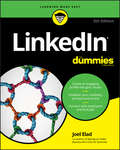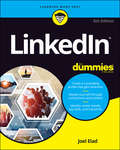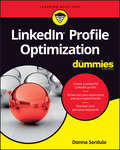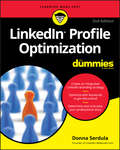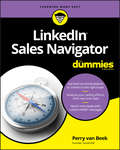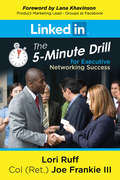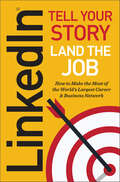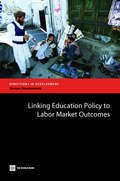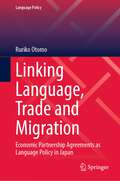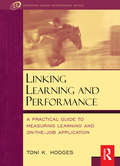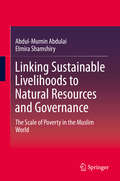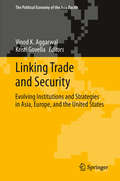- Table View
- List View
LinkedIn Corporation, 2012
by David B. Yoffie Liz KindSince its inception in 2003, LinkedIn had become a leading Silicon Valley institution with a brand name that was recognizable throughout the U.S. and in many countries overseas. As of March 2012, LinkedIn was the world's largest professional network on the Internet with $522.2 million in revenue in 2011 and more than 150 million members in over 200 countries. Unlike other major social networking sites, LinkedIn focused exclusively on fostering connections within the professional market. As LinkedIn's CEO thought about the future, he recognized the challenges in continuing to massively scale the company. At the same time, he focused on how LinkedIn could continue to use its vast amount of data to provide additional products and services for its members and customers.
LinkedIn For Dummies
by Joel EladMake LinkedIn your number one professional branding tool LinkedIn is the premiere social network for professionals looking to discover new opportunities, enhance personal branding, connect with other professionals, and make career advancements. With LinkedIn For Dummies, you’ll have step-by-step instructions on how to take advantage of the latest tools and features to do all of this and more. This book will teach you how to create an attractive profile that employers will notice, as well as ways to expand your network by making connections around the globe. You'll also learn how to best navigate the new user interface, write recommendations, take a course with LinkedIn Learning, and conduct your job search. Create an appealing, detailed profile Establish your credibility and personal brand Connect with employers and find jobs Request and write recommendations Whether you’re one of LinkedIn’s 500 million global members or brand new to the site, this authoritative resource helps you get the most out of the world’s largest professional network.
LinkedIn For Dummies
by Joel EladBrand yourself like a pro on LinkedIn LinkedIn multiplies what you know by the power of who you know to deliver the number one social platform for business professionals and new job seekers. LinkedIn For Dummies shows LinkedIn newcomers the best ways to discover new opportunities, enhance their personal brand, network with other professionals, and give an exponential boost to their career. Consider this book a passport to help you connect more successfully with many of LinkedIn’s 660+ million members in over 200 countries, as well as an expert guide to the platform’s tools and features and the proven tactics that get you noticed. In this friendly, all-access introduction to the LinkedIn scene, entrepreneurship guru Joel Elad clues you in on the essentials. Get the latest insight on how to create an attractive profile that will make employers give you a second glance as well as techniques for making useful connections across the globe. In no time at all you’ll also be right at home with the profile user interface and getting busy with adding content, searching for career opportunities, and, if you’re looking to hire for your company, recruiting top candidates. Build your personal brand and market it Sell yourself by highlighting skills, awards, and endorsements Get connected with LinkedIn groups Manage and make introductions via InMail Relationships matter: LinkedIn For Dummies gives you the online social skills to turn six degrees of separation into the colleagues, mentors, and friends who will transform your career—and your life.
LinkedIn Profile Optimization For Dummies
by Donna SerdulaOptimize your LinkedIn profile--and get results Your LinkedIn profile is essentially a platform to shape how others see you, highlight your abilities, products, or services, and explain how your work impacts lives. Yet many people simply copy and paste their resume and expect job offers and networking opportunities to start rolling in--but that isn't how it works. LinkedIn Profile Optimization For Dummies shows you how to create a profile that enhances your personal brand, controls how others see you, and shapes a successful future for your career. Whether your goal is job search, branding, reputation management, or sales, people are Googling you--and your LinkedIn profile is more often than not their first point of contact. With a focus on who you are, the value you deliver, and the culture you cultivate, the profile you'll create with the help of this guide will make that first connection a positive one--giving you a better chance to see results. Create a powerful LinkedIn profile Discover your personal keywords Showcase your experience and accomplishments Be seen on the world's largest professional social network You never get a second chance to make a great first impression, and LinkedIn Profile Optimization For Dummies helps to ensure you're presenting yourself in the best possible light.
LinkedIn Profile Optimization For Dummies
by Donna SerdulaGive your LinkedIn profile the makeover it deserves—and get the attention you deserve Look at your profile: you know it could be a little better. Too many LinkedIn users are just posting a basic resume and hoping for the offers to come flooding in, missing out on the incredible opportunity the platform offers to properly showcase their talents, products, and services to 610 million professionals in over 200 countries. LinkedIn is way more than a resume tool—to display your professional past and present—it’s also your career future and personal brand. Used to its fullest extent, it helps you demonstrate the unique value and culture you provide, the skills and aspirations that make you different, to get the outcomes you truly want. But how’s it done? Profile branding expert Donna Serdula pioneered the concept of LinkedIn Profile Optimization and through her Website, LinkedIn-Makever.com, has helped over 5000 professionals use LinkedIn to achieve increased success. In this guide she applies that experience to help you use all of LinkedIn’s capabilities to meet your goals, whether they be job search, reputation management, or sales—including how to: Create a memorable, successful profile Optimize personal keywords Showcase your experience, accomplishments, and unique value Use LinkedIn features to grow your network and more You never get a second chance to make a first impression—and people are Googling you right now: Get a fresh online look and get results!
LinkedIn Sales Navigator For Dummies
by Perry Van BeekMake selling a social affair! The ABCs of sales have changed. It's no longer: A-Always, B-Be, C-Closing. The new way of selling is: A-Always, B-Be, C-Contributing to your buyer's journey. Social selling is an effective way to engage with your customer, and the world's most powerful social selling tool for any B2B sales professional is LinkedIn Sales Navigator. It allows you to gain access to more leads, more InMail, and data to track your efforts. With the help of LinkedIn Sales Navigator For Dummies, you'll learn how to write effective InMail messages and engage with prospects on the world's most successful professional networking site. Along with utilizing those features, you'll also benefit from access to full profiles outside of your network, guidance on how to best optimize your own profile for sales opportunities, and much more. Use lead recommendations to get in front of the right buyer Analyze your social selling efforts with real-time data Reach more leads with customized InMail messages Save 30 - 60 minutes a day previously spent on acquisitions If you're a B2B sales professional who is new to LinkedIn Sales Navigator, this is the one-stop resource you can't be without.
LinkedIn: Tell Your Story, Land the Job
by Jeff Norman<p>Meet the World's Largest Career and Networking Site: LinkedIn <p>LinkedIn is dominating the world of business-based networking, yet many of its users don't know how to make the most of it, while others are hesitant to join yet another social network. Whether you're a job seeker, an employer in search of new talent, or a business looking to boost your visibility, make LinkedIn your social network of choice, this book your guide. <p><i>LinkedIn: Tell Your Story, Land the Job</i> will help you: <p> <li>Learn tips and tricks for building a strong LinkedIn profile, optimized for discovery <li>Write a concise professional summary, gather endorsements and recommendations, and highlight your skills <li>Create a virtual hub for current and potential employees and customers <li>Take advantage of LinkedIn's Company Pages to improve your visibility <li>Dig deeper into LinkedIn's offerings, by getting the most out of introduction requests, advanced search, media tools, and professional groups <li>Explore the pros and cons of the free vs. paid versions of LinkedIn</li> <p> <p>Dust off your LinkedIn Profile and make it shine with this visual, easy-to-follow handbook.</p>
LinkedIn: The 5-Minute Drill for Executive Networking Success
by Lori Ruff Joe FrankieLinkedIn: The 5-Minute Drill for Executive Networking Success is written for executives and transitioning military leaders to see the immediate benefit of using LinkedIn to network, build better teams, land new opportunities, pivot, change sectors, get promoted, and better merchandise their talents, expertise, and skill sets.Executives are busy people and LinkedIn is an extremely valuable resource. Once leaders know how to use LinkedIn for their desired purpose, they can quickly organize a 5-minute drill to accomplish their desired goals. LinkedIn represents the collaboration of two successful thought leaders, Lori Ruff and Joe Frankie III, both of whom have consulted with and crafted profiles for hundreds of executives since the early days of LinkedIn. They provide recommendations for representing oneself online as well as advice on how to navigate a daily routine for executives and leaders to keep themselves in sight and top of mind to people looking for someone just like them. Whether someone is representing their company or themselves, online image does matter and Lori and Joe show readers how to achieve online networking success.
LinkedIn® In One Hour for Lawyers
by Dennis Kennedy Allison C. ShieldsLawyers work in a world of networks, connections, referrals, and recommendations. For many lawyers, the success of these networks determines the success of their practice. LinkedIn®, the premier social networking tool for business, can help you create, nurture, and expand your professional network and gain clients in the process. LinkedIn® in One Hour for Lawyers provides an introduction to this powerful tool in terms that any attorney can understand
Linkedin: Tell Your Story, Land the Job
by Jeff NormanMeet the World's Largest Career and Networking Site: LinkedInLinkedIn is dominating the world of business-based networking, yet many of its users don't know how to make the most of it, while others are hesitant to join yet another social network. Whether you're a job seeker, an employer in search of new talent, or a business looking to boost your visibility, make LinkedIn your social network of choice, this book your guide.LinkedIn: Tell Your Story, Land the Job will help you: Learn tips and tricks for building a strong LinkedIn profile, optimized for discovery Write a concise professional summary, gather endorsements and recommendations, and highlight your skills Create a virtual hub for current and potential employees and customers Take advantage of LinkedIn's Company Pages to improve your visibility Dig deeper into LinkedIn's offerings, by getting the most out of introduction requests, advanced search, media tools, and professional groups Explore the pros and cons of the free vs. paid versions of LinkedIn
Linking Education Policy to Labor Market Outcomes
by Tazeen Fasih'Linking Education Policy to Labor Market Outcomes' examines current research and new evidence from Ghana and Pakistan-representative of two of the poorest regions of the world-to assess how education can increase income and help people move out of poverty. This study indicates that in addition to early investments in cognitive and noncognitive skills-which produce a high return and lower the cost of later educational investment by making learning at later ages more efficient-quality, efficiency, and linkages to the broader macro-economic context also matter. Education and relevant skills are still the key determinants of good labor market outcomes for individuals. However, education policies aimed at improving skills will have a limited effect on the incomes of that skilled workforce or on the performance of a national economy if other policies that increase the demand for these skills are not in place. For education to contribute to national economic growth, policies should aim at improving the quality of education by spending efficiently and by adapting the basic and postbasic curricula to develop the skills increasingly demanded on the global labor market, including critical thinking, problem solving, social behavior, and information technology.
Linking Employee Satisfaction to Business Results (Studies on Industrial Productivity: Selected Works)
by Paula S. TopoloskyFirst Published in 2000. Routledge is an imprint of Taylor & Francis, an informa company.
Linking Expertise and Naturalistic Decision Making (Expertise: Research and Applications Series)
by Gary Klein Eduardo SalasThis book contains selected papers presented at the 1998 conference on Naturalistic Decision Making (NDM). The objectives of the conference were to: *make American researchers more aware of NDM research being conducted abroad, particularly in Europe; *connect NDM research with work in management and industry, to stretch beyond the military and paramilitary focus; and *formulate a more explicit connection between NDM and expertise. These objectives are reflected in the chapters of this volume.
Linking Global Trade and Human Rights
by Daniel Drache Lesley A. JacobsDuring the global economic crisis of 2008, countries around the world used national policy spaces to respond to the economic crisis in ways that shed new light on the possibilities for linkages between international trade and human rights. This book introduces the idea of policy space as an innovative way to reframe recent developments in global governance. It brings together a wide-ranging group of leading experts in international law, trade, human rights, political economy, international relations, and public policy who have been asked to reflect on this important development in globalization. Their multidisciplinary contributions provide explanations for why the global landscape for national policy space has changed, clearly illustrate instances of this change, and project the future paths for policy development in social and economic policy spaces, especially with reference to linkages between international trade and human rights in countries from the Global North as well as Brazil, China, and India.
Linking Health and Education for African American Students' Success
by Nadine M. Finigan-CarrThe linkages between a student’s health and a student’s ability to learn have been well established. Children who are sick stay home; and, children at home cannot learn if they are not in school leading to increased dropout rates among other educational outcomes. However, an understanding of this concept is just the beginning of understanding how education and public health are inextricably linked. In light of this, Linking Health and Education for African American Students’ Success examines health disparities and education inequities simultaneously and moves beyond a basic understanding of health and education in K-12 school programs. The structural inequalities which lead to reduced academic attainment mirror the social determinants of health. Education is one of the most powerful determinants of health, and disparities in educational achievement as a result of structural inequalities closely track disparities in health. These disparities lead to both sub-standard healthcare and reduced academic attainment among children from underserved minorities in the United States, especially African Americans. This book discusses how this may result in children with poorer mental health outcomes; higher school dropout rates; increased risks of arrests and incarceration; higher rates of chronic diseases and mortality; and overall diminished opportunities for success, while providing suggestions as to how to address these issues. This results in an insightful read for researchers, academics and practitioners in the fields of healthcare and education.
Linking Industries Across the World: Processes of Global Networking (Routledge Revivals)
by Eike W. SchampOriginally published in 2005. This book examines how regional industries use different networks on various geographical scales in order to withstand increasing competition in a globalising world. It argues that new forms of global governance of networked industries are emerging, in particular in those areas that have only recently been incorporated into the global economy such as Eastern Europe, Asia and Southern Africa. The book addresses a number of issues, including the different forms of institutional arrangements that contribute to the formation of heterogeneous global industrial networks. It also raises the issue of national institutions that still matter in network formation. The focus of the book is on how to improve regional and sectoral competitiveness in a global context and it suggests this is best achieved by a close analysis of global linkages, an evolutionary perspective on processes taking place, and a more differentiated view on globalisation.
Linking Language, Trade and Migration: Economic Partnership Agreements as Language Policy in Japan (Language Policy #33)
by Ruriko OtomoThis book examines the effect of trade policy on language which represents an underrecognized area in the field of language policy and planning. It argues that trade policies like Japan’s Economic Partnership Agreements (EPAs) have important consequences for national language (education) policies and for discourses about language and nation. Since 2008, Japan has signed the EPAs with Indonesia, the Philippines and Vietnam to recruit migrant nurses and eldercare workers and manage their mobility by means of pre-employment language training and the Japanese-medium licensure examinations. Through the analysis of these language management devices, this book demonstrates that the EPAs are a manifestation and representation of contemporary language issues intertwined particularly with pressing issues of Japan’s social aging and demographic change. As the EPAs are intertwined with welfare, economy, social cohesion, and international political and economic relations and competitiveness, the book presents a far more complex picture of and a richer potential of language policy.
Linking Learning and Performance
by Toni HodgesThis book provides a step-by-step approach for developing learning and performance measures and a method for analyzing and reporting results. The easy to use format serves as a quick reference—featuring the necessary checklists to evaluate the situation and tools for immediate application in a number of organizational settings—sales, leadership, and technical. It will prove an invaluable resource for anyone involved in training, HRD, human resource measurement and evaluation, and performance improvement.
Linking Local and Global Economies: The Ties that Bind (Routledge Studies In The Modern World Economy)
by Carlo Pietrobelli Árni SverrissonClusters of small and medium sized enterprises (SMEs) have to adapt continually to a fast changing environment. This new book, containing contributions on countries ranging from Italy and Mexico to China and India, recognises the disparity between conditions in these countries and poses some interesting questions about what might be termed post clu
Linking Local and Global Sustainability
by Howard Harris Stephen Mckenzie Sukhbir SandhuThe book takes a holistic approach to sustainability. Acknowledging the Brundtland definition, that sustainable development meets the needs of the present without compromising the ability of future generations to meet their own needs, the book is specifically concerned with the ethics of contemporary social and environmental sustainability activity and thinking. It is concerned with the role of institutions-both local and global in achieving sustainability initiatives. All twelve chapters extend sustainability-conceptually, empirically and theoretically, and in doing so provide insights into linking local and global sustainability. The book refocuses sustainability as a series of interwoven and dynamic relationships, backed by just ethical decision-making, which begin locally, and reach out to impact the global level.
Linking Strategy and Innovation: Materials Technology Corp.
by Clayton M. ChristensenMaterials Technology Corp. (MTC), a high-tech materials company, is struggling in its development portfolio and to achieve a better record of delivering new products on time.
Linking Strategy, IT Governance, and Performance
by Jeanne W. Ross Peter WeillThis chapter looks at IT governance design, identifying the range of strategic objectives enterprises pursue and describing how enterprises harmonize individual IT decisions and how IT governance changes to reflect strategic business changes. This chapter was originally published as chapter 6 of "IT Governance: How Top Performers Manage IT Decision Rights for Superior Results."
Linking Sustainable Livelihoods to Natural Resources and Governance
by Abdul-Mumin Abdulai Elmira ShamshiryThis book investigates the current level and trend of poverty in the Muslim World, including selected countries in Africa, the Middle East and Central Asia, East Asia, the Pacific and South America. Authors explore themes of poverty reduction, poverty alleviation and the extent of influences on social and economic development, particularly natural resource endowments (especially mineral resources) and their utilization. Chapters explore theory and practice, including governance and programmes, and take a detailed look at Zakat as a faith-based policy tool, to reduce poverty and improve livelihoods and thus contribute to better environmental stewardship. The final chapters look at development questions in the Muslim World and make policy recommendations, including a proposed multi-dimensional development collaboration model called the Development Collaboration Octagon Model (DeCOM). Readers will discover theoretical explanations of poverty and how poverty hampers the development of many nations because the poor are unable to partake actively in the development process. Poverty indicators and measurement are discussed, and trends of economic growth including productivity, manufacturing, trade patterns, investment and saving activity, and socio-economic developments are all explored: supporting data is presented in tables and figures, throughout this text. Authors explore the potency and success stories of public poverty alleviation strategies and programmes pursued in the Muslim world, especially the extent to which the institution of Zakat has been effectively incorporated into public poverty alleviation strategies. Policy options required to enhance social and economic development are proposed, to help pull the poor out of the poverty trap into the mainstream economy in the Muslim world. This work will appeal to anyone wishing to scrutinise poverty, its parameters and its relationship with the development of countries in the Muslim world. Scholars in the fields of economics, sociology, geography and Islamic studies will all find something of value here.
Linking Trade and Security
by Vinod K. Aggarwal Kristi GovellaThe connections between trade and security are hardly new. Analysts and practitioners have clearly recognized this interrelationship since the mercantilist arguments of the 16th and 17th centuries. Despite wishful economic liberal thinking that might prefer to separate the political from the economic, it is widely recognized that trade and security are fundamentally interconnected in the foreign policy of states. Over time, as new forms of trade policy have come into being and the international security environment has evolved, the nexus of these two spheres has grown more complex and scholars have struggled to understand their interconnection This edited volume addresses linkages between trade and security by examining the influence of security factors in driving trade policy measures and the corresponding implications of different types of trade arrangements for international security. Ultimately, the project shows that several elements--traditional economic factors, traditional security factors, and human security factors--can affect the development of trade agreements and unilateral policies, and that trade policies may have both a direct and an indirect effect on traditional and human security. The project focuses on Asia, a region where economics is increasingly important but many security issues still linger unresolved, as a primary setting to test trade linkage theories. It also provides a comparative perspective through examination of how the EU and US have used their trade policies to achieve non-economic goals and how these policies have influenced their security environment. Case studies in this project cover key trade institutions and agreements including the World Trade Organization, the Association of Southeast Asian Nations, ASEAN Plus Three, the East Asia Summit, the Asia-Pacific Economic Cooperation forum, the Shanghai Cooperation Organization, and bilateral preferential trade agreements.
Linking Up and Reaching Out in Bangladesh: Information and Communications Technology for Microfinance
by Cecile Thioro Niang Aneeka Rahman Zaid Safdar Henry K. Bagazonzya A. K. M. AbdullahThe microfinance sector in Bangladesh has matured rapidly in the past 30 years and now boasts the largest number of clients in the entire world. Despite these successes, the day-to-day operations of most microcredit institutions in Bangladesh are done manually. The introduction of a centralized information and communications technology (ICT) platform in the microfinance sector will provide further cost savings by streamlining data so that errors, omissions, and duplications (client overlap) are eliminated. Moreover, the introduction of a centralized ICT platform will help to ensure transparency through the standardization of information exchange and accounting mechanisms, increase outreach to rural areas, and integrate the largely informal microfinance sector with the formal financial system. 'Linking Up and Reaching Out in Bangladesh' shows how the establishment of a centralized microfinance platform would revolutionize the country's microfinance sector. This volume will be a useful guide for practitioners, policy makers, and microfinance institutions around the world.

